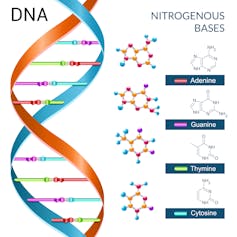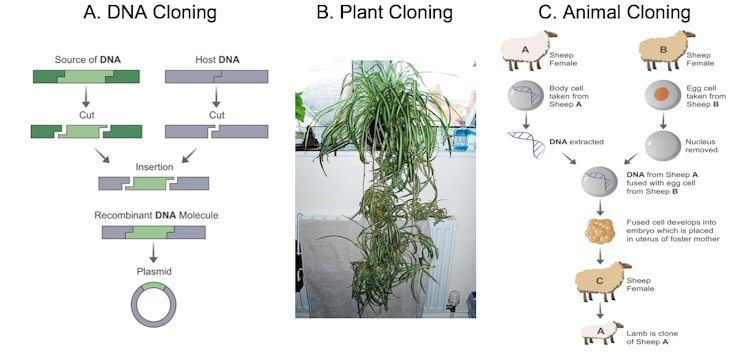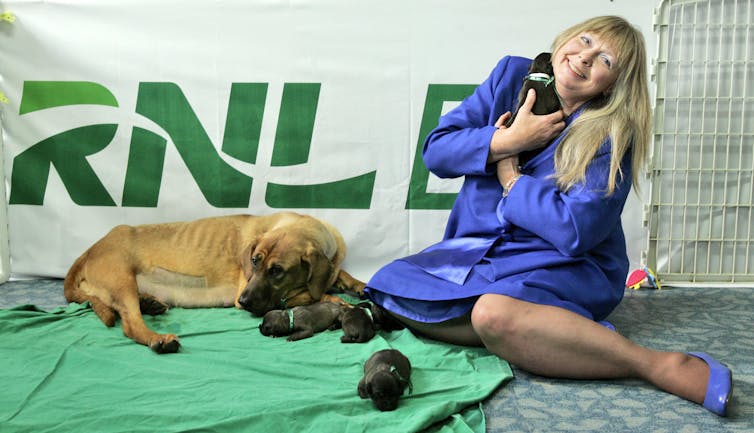Could villains clone themselves to take over the world?
A scientist explains how researchers use cloning in the lab and what is the difference between cloning a gene versus cloning an entire organism.

If asked about clones, most people think of evil sci-fi characters. However, in real life, the word “clone” often has broader, far more positive applications. Just as office workers replicate documents by using copy machines, scientists like us who study plant disease use the biological equivalent of a copier to clone genes, cells, and tissues, as well as entire organisms.

DNA cloning
The most common type of cloning done in the lab is gene replication. Each gene is a segment of DNA (deoxyribonucleic acids) that is made up of pairs of chemicals called bases. These base pairs form DNA’s iconic double helix. Depending on the species, the whole genome could have anywhere from few thousands to billions of base pairs that make up just a few to tens of thousands of genes. The human genome alone has 3 billion base pairs that make up about 30,000 genes.
Genes code for traits such as eye color and height, as well as crucial features like the development of the heart and the five senses. Some genes can even predispose people toward certain diseases or personalities.
In order to unlock the secrets of life hidden in DNA, scientists are examining how individual genes function. To do so, they first copy a section of DNA that contains the gene of interest. Copying, or cloning, is often done via a biochemical reaction called polymerase chain reaction, or PCR, that mimics natural DNA replication. Once copied, the gene of interest can also be inserted to a plasmid (a ring of DNA) which is taken up by the simple bacterium Escherichia coli (E. coli).
When the E. coli replicates, the plasmids are also replicated, generating exponential copies of the gene. Gene cloning helps scientists reveal the sequence of DNA in a gene that encodes a trait. This ultimately enables them to manipulate the trait in an organism by modifying the gene – for example, changing its expression level and/or changing its sequence. Through these manipulations, scientists can figure out what the gene does and how it works. In some cases, such information can lead to earlier detection and better treatments of debilitating medical conditions and diseases.

Cloning cells, tissues and organisms
Similarly, scientists can clone whole cells and tissues by providing the right nutrients and environment. Done carefully, cell cloning is used to replace dead cells in hospital patients. For replacement of larger body regions, tissue cloning is vital.
Some organisms can even regrow whole parts of their bodies in response to organ loss; for example, lizards can regrow their tails and planarians (a type of flatworm) can replace their own heads. For some plants, in vitro culture has been routinely used to generate many copies of certain organs: for example, hairy roots or multiple shoots, without the presence of the whole plant body.
However, the cloning of animal organs is not so easy for human researchers to accomplish. Organ cloning is not just simply putting the correct types of cells together to make tissues and then the tissues together to make an organ. To make a functional organ, such as a heart that can beat, one needs to go back to the beginning of heart development and find a heart progenitor cell. Then this cell is somehow to be tricked to go through the steps for heart development in the absence of the context of the whole body and eventually grow to be the heart. How we can achieve this is still a mystery. Scientists are working hard, but only the future will tell if we can accomplish human organ cloning at a level that would revolutionize successful organ transplants and replacements.
All of this, however, pales in comparison to the cloning of a whole multicellular organism. Cloning an organism produces an exact genetic replica without requiring sexual reproduction. Plants are undoubtedly the champions in this respect; some plants can simply regrow from cuttings or grow a clone from parts of their bodies.
But animal cloning has encountered several obstacles. This process currently involves transferring a nucleus (DNA) from a donor adult cell to an egg cell that has had its nucleus (DNA) removed. This chimeric cell is then stimulated to become embryonic or pluripotent, meaning it can divide and differentiate into other types of cells and eventually form an embryo. Although this might appear simple, this is the most challenging step of cloning an organism.
Once the embryo is obtained, the next step is quite straightforward; the embryo is implanted into a female’s womb and the clone will continue to develop. This implantation step is commonly done in humans as part of the process of in vitro fertilization. Babies produced through in vitro fertilization carry one set of DNA from the father (sperm donor) and another set from the mother (egg donor). However, clones will have the same chromosomal DNA as the initial adult cell that donates its nucleus (DNA). Because of the difficulties associated with the cloning process, few experts in the world have successfully cloned animals. Additionally, some of the cloned animals exhibit health problems or reduced lifespans. Despite this, the list of cloned animals continues to grow, including sheep, cows, oxen, cats, dogs, deer, horses, mules, rabbits and rats.

Supervillain clones
With cloning of whole organisms a reality (though currently not feasible for widespread use), you may wonder if one day, an evil villain would be able to make thousands of copies of him or herself. Would that evil villain then take over the world?
The answer to this question has many layers.
Let’s consider the individual clones. Since they are humans, the clones will not simply respond to commands like robots or be puppet-like extensions of the original villain. As with identical twins, the clones may share predispositions, but their personalities will not be the same. Since so much of personality and behavior is influenced by the environment, the clones may even grow to oppose the villain! And, while the villain may not care, there are ethical issues involved with human cloning. Would society accept the act of cloning? Would clones be given the full rights of natural-born humans? How would it affect families if they decided to clone deceased loved ones?
Even amid these questions, organismal cloning has tremendous applications for society. It helps us to save species around the world from endangerment and extinction, although it doesn’t generate the genetic diversity required to maintain a healthy population. It is also an important tool to study diseases and to replicate individual organisms with important or rare characteristics that could be lost through breeding, such as cows with high milk production or animals that can make valuable medicinal compounds.
Although both promising and exciting, the road of cloning entire organisms is filled with ethical pitfalls and scientific conundrums; perhaps as a society, we are not ready to deal with the evil villains and their clones just yet.
Hua Lu receives funding from National Science Foundation.
Jessica Allison works for Dr. Hua Lu.
Read These Next
Why the chemtrail conspiracy theory lingers and grows – and why Tucker Carlson is talking about it
A communications researcher lays out the dynamics of conspiracy theory belief and why they gain traction…
How does your immune system stay balanced? A Nobel Prize-winning answer
Regulatory T cells help your immune system distinguish between ‘self’ and ‘nonself’ – and…
How Squishmallow collecting helped me cope with grief, make new enemies and find ‘villains’ worth st
‘Brand communities’ are sites of surprising human drama. A marketing expert explains what she found…





